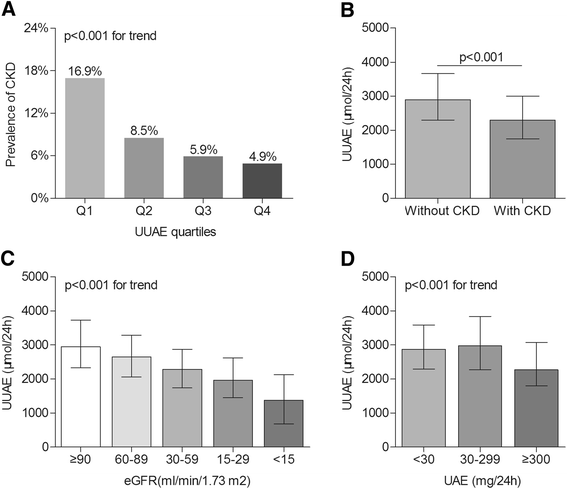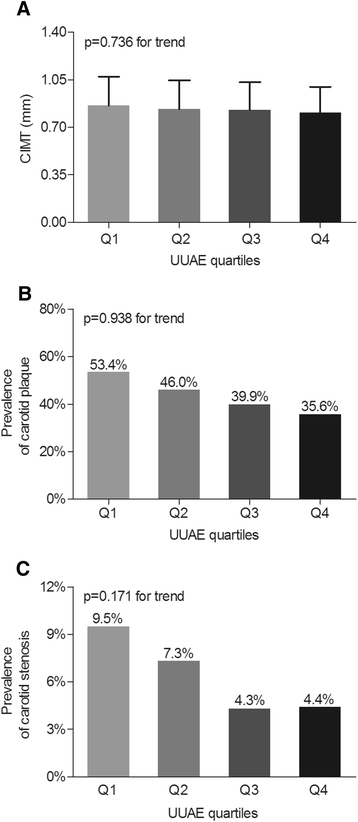Decreased urine uric acid excretion is an independent risk factor for chronic kidney disease but not for carotid atherosclerosis in hospital-based patients with type 2 diabetes: a cross-sectional study - PubMed (original) (raw)
Decreased urine uric acid excretion is an independent risk factor for chronic kidney disease but not for carotid atherosclerosis in hospital-based patients with type 2 diabetes: a cross-sectional study
Lian-Xi Li et al. Cardiovasc Diabetol. 2015.
Abstract
Background: The associations between urine uric acid excretion (UUAE) and chronic kidney disease (CKD)/atherosclerosis have not been investigated. Our aims were to investigate the relationships between UUAE and CKD and carotid atherosclerotic lesions in hospitalized Chinese patients with type 2 diabetes.
Methods: This was a cross-sectional study that was conducted with 2627 Chinese inpatients with type 2 diabetes. UUAE was determined enzymatically using a single 24-h urine collection. The subjects were stratified into quartiles according to their UUAE levels. Carotid atherosclerotic lesions, including carotid intima-media thickness (CIMT), plaque and stenosis, were assessed by Doppler ultrasound. Both CKD and carotid atherosclerotic lesions were compared between the UUAE quartile groups.
Results: After adjustment for confounding factors, there was a significant decrease in the prevalence of CKD in the patients with type 2 diabetes across the UUAE quartiles (16.9%, 8.5%, 5.9%, and 4.9%; p < 0.001). Multiple logistic regression analyses revealed that the UUAE quartiles were significantly and inversely associated with the presence of CKD (p < 0.001). Compared with the diabetics in the highest UUAE quartile, those in the lowest quartile exhibited a nearly 4.2-fold increase in the risk of CKD (95% CI: 2.272-7.568; p < 0.001). The CIMT value (0.91 ± 0.22 mm for the diabetics with CKD and 0.82 ± 0.20 mm for the diabetics without CKD, p = 0.001) and the prevalence of carotid plaques (62.1% for the diabetics with CKD and 41.8% for the diabetics without CKD, p = 0.025) were significantly higher in the diabetics with CKD than in those without CKD. However, there was no obvious difference in carotid atherosclerotic lesions across the UUAE quartiles after controlling for the confounding factors.
Conclusions: Decreased UUAE was closely associated with the presence of CKD but not with carotid atherosclerotic lesions in hospitalized Chinese patients with type 2 diabetes. Our results suggest that UUAE is an independent risk factor for CKD in type 2 diabetes. In selected populations, such as patient with type 2 diabetes, the role of uric acid in atherosclerosis might be the result of other concomitant atherosclerotic risk factors, such as CKD.
Figures
Figure 1
Comparison of CKD among the UUAE quartiles. (A) Comparison of the prevalence of CKD among the UUAE quartile groups after adjusting for age, sex, and DD. The P values for the trends were <0.001. (B) Comparison of the UUAE levels between the diabetics with and without CKD after adjusting for age, sex, and DD. The P value was <0.001. (C) Comparison of UUAE levels among the different eGFR levels after adjusting for age, sex, and DD. The P values for the trends were <0.001. (D) Comparison of UUAE levels among the different UAE levels after adjusting for age, sex, and DD. The P values for the trends were <0.001.
Figure 2
Comparison of carotid atherosclerotic lesions among the UUAE quartiles. (A) Comparison of the CIMT values among the UUAE quartile groups after adjusting for age, sex, and DD. (B) Comparison of the prevalence of carotid atherosclerotic plaques among the UUAE quartile groups after adjusting for age, sex, and DD. (C) Comparison of the prevalence of carotid atherosclerotic stenosis among the UUAE quartile groups after adjusting for age, sex, and DD.
Figure 3
Comparison of carotid atherosclerotic lesions between the diabetics with and without CKD. (A) Comparison of the CIMT values between the diabetics with and without CKD after adjusting for age, sex, and DD. (B) Comparison of the prevalence of carotid atherosclerotic plaques between the diabetics with and without CKD after adjusting for age, sex, and DD. (C) Comparison of the prevalence of carotid atherosclerotic stenosis between the diabetics with and without CKD after adjusting for age, sex, and DD.
Similar articles
- Decreased urine uric acid excretion is associated with diabetic retinopathy but not with lower limb atherosclerosis in hospitalized patients with type 2 diabetes.
Li LX, Lu JX, Shuai HP, Xia HF, Zhang R, Wang JW, Chen MY, Li TT, Bao YQ, Jia WP. Li LX, et al. Atherosclerosis. 2015 Sep;242(1):13-8. doi: 10.1016/j.atherosclerosis.2015.06.051. Epub 2015 Jun 30. Atherosclerosis. 2015. PMID: 26162315 - Coexistence of hyper-uricaemia and low urinary uric acid excretion further increases risk of chronic kidney disease in type 2 diabetes.
Chen MY, Wang AP, Wang JW, Ke JF, Yu TP, Li LX, Jia WP. Chen MY, et al. Diabetes Metab. 2019 Dec;45(6):557-563. doi: 10.1016/j.diabet.2019.03.001. Epub 2019 Mar 27. Diabetes Metab. 2019. PMID: 30928248 - Urine uric acid excretion is associated with nonalcoholic fatty liver disease in patients with type 2 diabetes.
Zhao CC, Wang AP, Li LX, Li TT, Chen MY, Zhu Y, Yu TP, Bao YQ, Jia WP. Zhao CC, et al. J Diabetes Complications. 2016 Aug;30(6):1074-80. doi: 10.1016/j.jdiacomp.2016.04.017. Epub 2016 Apr 26. J Diabetes Complications. 2016. PMID: 27161518 - Urine Uric Acid Excretion Levels are Positively Associated with Obesity and Abdominal Obesity in Type 2 Diabetes Patients without Chronic Kidney Disease.
Liu F, Chen S, Zhao W, Chen M, Ke J, Zhang Z, Lu J, Li L. Liu F, et al. Diabetes Metab Syndr Obes. 2021 Dec 1;14:4691-4703. doi: 10.2147/DMSO.S335558. eCollection 2021. Diabetes Metab Syndr Obes. 2021. PMID: 34880638 Free PMC article. - Uric Acid and Atherosclerosis in Patients with Chronic Kidney Disease: Recent Progress, Mechanisms, and Prospect.
Liu Y, Li Z, Xu Y, Mao H, Huang N. Liu Y, et al. Kidney Dis (Basel). 2025 Mar 3;11(1):112-127. doi: 10.1159/000543781. eCollection 2025 Jan-Dec. Kidney Dis (Basel). 2025. PMID: 40124130 Free PMC article. Review.
Cited by
- The coexistence of carotid and lower extremity atherosclerosis further increases cardio-cerebrovascular risk in type 2 diabetes.
Li MF, Zhao CC, Li TT, Tu YF, Lu JX, Zhang R, Chen MY, Bao YQ, Li LX, Jia WP. Li MF, et al. Cardiovasc Diabetol. 2016 Mar 5;15:43. doi: 10.1186/s12933-016-0360-2. Cardiovasc Diabetol. 2016. PMID: 26944724 Free PMC article. - Effect of Cichorium intybus L. seed extract on renal parameters in experimentally induced early and late diabetes type 2 in rats.
Pourfarjam Y, Rezagholizadeh L, Nowrouzi A, Meysamie A, Ghaseminejad S, Ziamajidi N, Norouzi D. Pourfarjam Y, et al. Ren Fail. 2017 Nov;39(1):211-221. doi: 10.1080/0886022X.2016.1256317. Epub 2016 Nov 16. Ren Fail. 2017. PMID: 27846769 Free PMC article. - Identification of two novel subgroups in patients with diabetes mellitus and their association with clinical outcomes: A two-step cluster analysis.
Xiong XF, Yang Y, Wei L, Xiao Y, Li L, Sun L. Xiong XF, et al. J Diabetes Investig. 2021 Aug;12(8):1346-1358. doi: 10.1111/jdi.13494. Epub 2021 Feb 14. J Diabetes Investig. 2021. PMID: 33411406 Free PMC article. - The combination of nonthyroidal illness syndrome and renal dysfunction further increases mortality risk in patients with acute myocardial infarction: a prospective cohort study.
Wang JW, Ren Y, Lu ZG, Gao J, Zhao CC, Li LX, Wei M. Wang JW, et al. BMC Cardiovasc Disord. 2019 Mar 4;19(1):50. doi: 10.1186/s12872-019-1027-1. BMC Cardiovasc Disord. 2019. PMID: 30832591 Free PMC article. - Association of urinary calcium excretion with chronic kidney disease in patients with type 2 diabetes.
Wang Y, Chen Y, Yu Y, Pan X, Fu G. Wang Y, et al. Int Urol Nephrol. 2024 Aug;56(8):2715-2723. doi: 10.1007/s11255-024-03978-x. Epub 2024 Mar 18. Int Urol Nephrol. 2024. PMID: 38498272
References
Publication types
MeSH terms
Substances
LinkOut - more resources
Full Text Sources
Other Literature Sources
Medical


